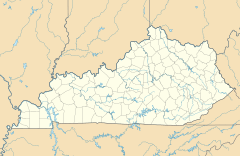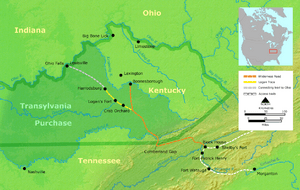Big Bone, Kentucky facts for kids
Quick facts for kids
Big Bone
|
|
|---|---|
| Country | United States |
| State | Kentucky |
| County | Boone |
| Time zone | UTC-5 (Eastern (EST)) |
| • Summer (DST) | UTC-4 (EDT) |
| GNIS feature ID | 487080 |
Big Bone is a small, quiet community in southern Boone County, Kentucky, United States. It is located near the Ohio River to the west and Big Bone Creek to the south. The community is named after a famous natural area nearby called Big Bone Lick. This special place is known for its prehistoric mineral lick and the many ancient animal bones found there. You can find Big Bone Lick State Park in this area.
Contents
History of Big Bone Lick
Big Bone Lick is a very important landmark near the Big Bone community. It is now part of Big Bone Lick State Park. For a long time, the native people of the area knew about this "lick," which is a place where animals come to lick salt and minerals from the ground.
Ancient Animal Discoveries
The area became famous because of the incredibly large fossil bones found in the wet, swampy areas around the salt lick. These bones belonged to huge animals like mammoths and mastodons. Animals need salt in their diets, so they would gather at these mineral springs. The springs are formed when water flows through layers of limestone and shale, picking up dissolved salts and bringing them to the surface. This creates salty water, also known as brine.
Early Attempts to Extract Salt
In 1809, people tried to extract salt from the salty spring water. They built a salt furnace with large kettles. However, they soon found out that the water wasn't very salty. They needed to boil down 500 to 600 gallons of water to get just one bushel of salt. Because it was so much work for so little salt, the project failed by 1812.
The Clay House Resort
A resort hotel called the Clay House opened nearby in 1815. Visitors came to bathe in the mineral springs, believing the water had healing powers. The resort also became popular with naturalists. These scientists and collectors came to search for bones for museums or their own collections. The Clay House closed in 1830, but the salt springs remained a popular spa until 1847. Another hotel was built in 1870. A post office named Bigbone was opened in 1890 and operated until 1941.
Geography of Big Bone
Big Bone Creek flows into the Ohio River at a point about 516.8 miles below Pittsburgh. The mouth of the creek is where Boone and Gallatin Counties in Kentucky meet. The creek is wide enough for boats for several miles and flows through Big Bone Lick State Park.
Big Bone Island
Big Bone Island used to be a small, natural island in the Ohio River. It was made of sand and gravel and was located near the mouth of Big Bone Creek. The island was just south of the Boone County line, in Gallatin County, Kentucky. It was a popular spot for fishing and camping and is part of the local stories and history.
However, Big Bone Island has now disappeared. This happened mostly because the river level rose after the Markland Dam was built. Also, during a big flood in 1978, large chunks of floating river ice destroyed most of the plants and carried away the soil.
The 1978 Floods
In January 1978, the Ohio River experienced a very rapid rise in water levels. The water went from about 29.6 feet on January 25 to 53.9 feet by January 30. This was during one of the coldest winters in the history of southwestern Ohio.
This rapid rise caused a huge jam of ice on the river. On January 27, 1978, decisions made by the U.S. Army Corps of Engineers at the Markland Dam caused this ice jam to break. When it broke, a "wall of ice and water" rushed downstream. This event was considered one of the worst disasters on the Ohio River in modern times.
The flood caused a lot of damage. Docks, barges, and boats were pushed against or through the Markland Dam. A towboat and seven barges sank at the dam, and several other barges were swept away or got stuck. During this powerful flood, the ice literally "shaved off" Big Bone Island, causing it to disappear.




